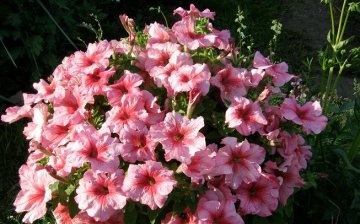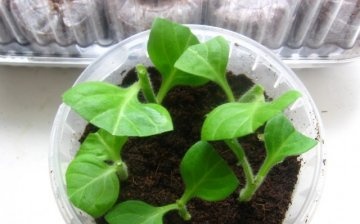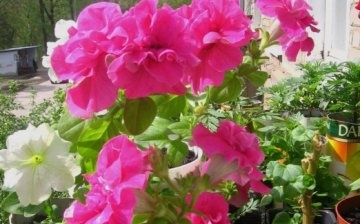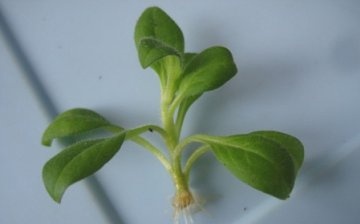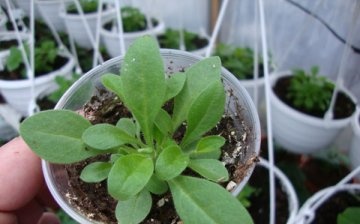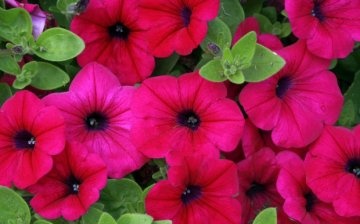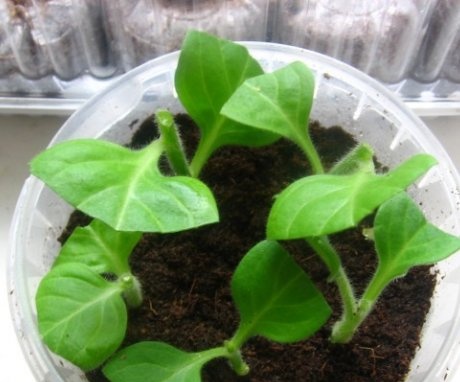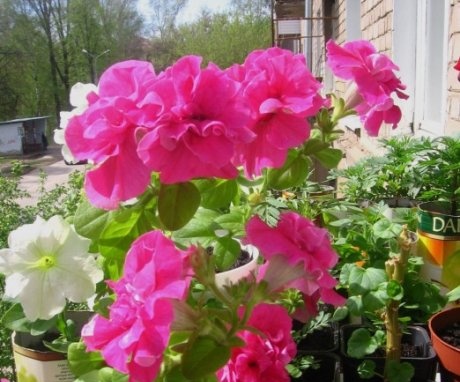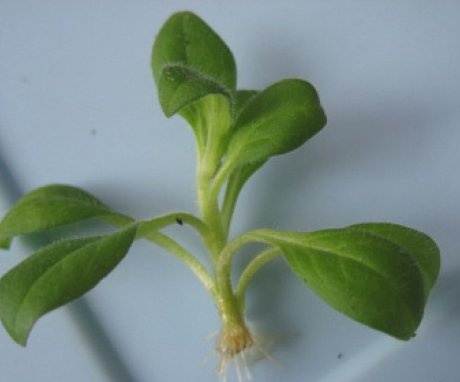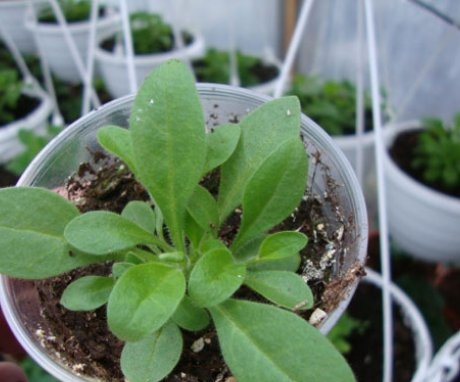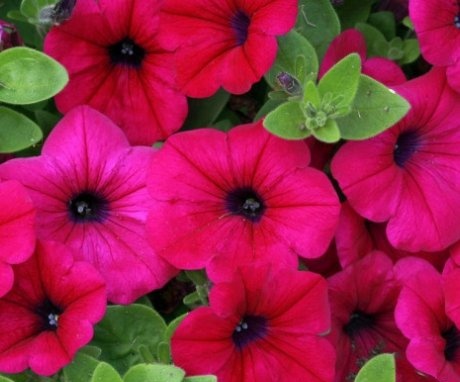Correct grafting of petunias, features of caring for young plants
Petunia is one of the most beloved plants of many flower growers. Petunia flowers are large and bright, which is perfect for both garden and home growing. But there is one problem that can cause inconvenience: petunia gives very few seeds and most of them do not germinate in the future, so multiplying the plant with seeds will not bring success, but only take away precious time.
Content:
- The advantage of cuttings over other types of propagation
- How to store petunia in the autumn-winter period
- How to cut petunias
- Care of young petunias
- Secrets of abundant growth and flowering of petunias
The advantage of cuttings over other types of propagation
The best breeding method for petunias is cuttings.
Cutting is one of the ways of vegetative reproduction of plants. Thanks to him, in a short time it is possible to grow any type of plant without high costs.
Some species can still be grown using seeds that are commercially available. But you need to carefully follow the technology and properly care for the entire period, starting with sowing, ending with transplanting seedlings to a permanent place.
Each flower is propagated by cuttings at a specific time:
- As for petunias, the most favorable time is winter.
- It will not be worse if the cuttings are carried out until May, but it is better not to wait until the heat.
- Terry varieties are better tolerated in warm weather. For example, calibrachoa can be cut year-round, the most important thing is to provide access to light and maintain favorable conditions.
To choose the most optimal breeding time, you need to learn more about a particular variety. Vegetative propagation is used both for young plants and for more mature ones, and individuals are taken, which grew from seed, and last year's bushes.
How to store petunia in the autumn-winter period
For cuttings of petunias, it is better to choose the largest and healthiest plants.
For example, for growing terry varieties, individuals with the most large and bright flowers.
By the end of August, petunias are removed for storage, this will require:
- Dig up the plant along with a lump of earth, the plant is transplanted into separate pots, the diameter of which must be at least 15 cm
- The plant will survive the winter more easily if you cut off old shoots.
- The temperature of the room in which the mother liquors will be stored should be constant and at about 10 degrees.
- If the room temperature exceeds 15 degrees, then the petunias will need to be illuminated for up to 12 hours every day. That is, the lower the temperature of the room in which the mother liquors hibernate, the less light they need.
- It is important to provide a favorable moisture-thermal regime.
- The air should not be dry, and the soil should not be too moist.
- Watering petunias need to be provided only when the leaves begin to drop.
- The plant does not need feeding, only occasionally force and potash fertilizers can be applied.
- In winter, petunia does not look very attractive, but this does not mean that it has begun to fade, by the spring the plant will regain its former bright appearance.
As for the ampel varieties, it is better to plant them in separate pots in the spring, and transfer them to a cool room on the onset of the first cool days. For these plants, it will be much easier without a summer transplant.
Before transferring petunia to the house, the plant must be treated with pesticides.
Several times during the winter it will be necessary to treat the spider mite, during the period when the temperature drops below 20 degrees, it will be possible to stop the procedure, since the parasite will cease its activity. If the plant grew in the garden in the open field, then the earthen lump must be etched, since there may be slugs or earthworms between the roots.
How to cut petunias
When autumn and winter have passed, you need to start thinking about plant propagation.
First you need:
- Cut off the apical cuttings from the mother specimen, each about 10 cm long.
- All leaves from the cuttings can be removed, except for the top two, which are only cut in half.
Petunia cannot be called an unpretentious plant, so each operation with it must be carried out strictly according to the instructions.
- To plant root system well formed, the cuttings need to be dipped for a while in a solution with phytohormones.
- Since the root system of petunia is very powerful and thick, you should not neglect caring for it, since it is the roots that will affect the further development of the flower.
- After that, the cuttings are planted in boxes with wet sand or loose soil, the planting depth is 4 cm. The cuttings should be planted close to each other, literally 2-3 cm apart.
- Then the ground can be pressed with your hands and watered.
- The box should be placed in a bright place, previously covered with foil or glass.
The main points to follow when breeding petunias:
- You cannot use the same soil when reproducing the plant
- Daylight hours should last at least 10 hours, a fluorescent lamp will help in this matter
- Cuttings need to be sprayed 2 times a day.
- During hot weather, the plant watered 2 times a day, in moderate weather, once, the soil must be constantly moist
- Cut off cuttings cannot be kept outdoors, they must be immediately transplanted into the ground
- The temperature of the room in which young plants will grow should be in the range of 20-25 degrees.
Within a week, the plant will give the first fibrous roots. It is necessary to transplant petunias into separate pots after the appearance of the first leaves. Care is provided in the same way as for seedlings. If the plant begins to grow moldy, then watering must be stopped for a while, and the box must be rearranged in a well-ventilated room, and the dead leaves must be cut off.
Care of young petunias
Modern hybrid forms are considered especially demanding among petunias. At low temperatures, they do not germinate, and at high temperatures they grow too quickly, but they often get sick.
In order for the petunia to grow healthy and bright, it is recommended to add potassium permanganate to the spray water.
Within a week, the plant will give the first leaves. At this point, it is worth removing the glass or film. The material must be removed gradually, as the plant is still too weak and not accustomed to the environment.
To start:
- The cover is removed for 10 minutes a day, gradually increasing the time until full leaves are formed.
- It will be much more convenient for a plant to develop in an individual container, it will be healthier, and it will be much easier for the owner to transplant it into open ground.
- In order to strengthen the root system and protect the flower from the "black leg", the seedling deepens when diving down to the leaves themselves.
- The younger the plant, the more carefully it needs to be watered, this must be done carefully right under the root.
- Young plant you need to harden, for this, 2 weeks after the appearance of the first leaves, you need to open the window for 10 minutes, gradually increasing the time.
However, we are not talking about drafts or direct currents of cold air, this can, on the contrary, destroy the plant. That is, the ambient temperature should drop, but not the seedlings.
Highlights for petunia care:
- You need to provide the plant with light as often as possible, even at night it is recommended to turn on a dim light
- It is necessary to ensure that a crust does not form on the ground, then oxygen will be blocked and the plant will suffocate.
- If the root system develops quickly and fills the entire plant lump, then you need transplant a flower into a large container, it should not be cramped
- When growing rare, expensive varieties, you should additionally use peat tablets
Secrets of abundant growth and flowering of petunias
Petunia substrate it is better to choose or cook on your own based on peat, such a soil will provide high-quality drainage and give a good recharge. The soil must contain elements such as potassium, phosphorus and nitrogen. For the prevention of "black leg" it is recommended to water the substrate with Previcur-fungicide. If such a drug and its analogues are not available, then it is replaced with a solution of potassium permanganate.
The most optimal option from what the market provides is a universal substrate. It contains natural pure peat and a large amount of organic matter.
The first two weeks, seedlings and seedlings are not fertilized, but only watered and sprayed... It is important not to allow the soil to dry out; the wet-dry cycle must be followed.
You can apply fertilizer after transplanting the plants into a large container, this is done when several leaves appear.
When there was a pick, you can add a small amount of yellow crystal or any other universal fertilizer (1 tablespoon per bucket of water). In the pharmacy you can buy vitamins B1, B12 and microelements uniflor micro for spraying.
The older the plant becomes, the more fertilizers can be applied, bringing up to 3 times a week.
It is impossible to apply fertilizers and spray the sheets in one day, these procedures must be alternated.
Water for irrigation should be as clean and soft as possible, the best option is rain or snow, the water temperature should be several degrees higher than the soil temperature.
When using dirty, hard water, there may be changes in the structure of the substrate, death of roots and leaves due to salt, accumulation of toxic ions, non-assimilation of fertilizers, poor growth, etc.
More information can be found in the video.



